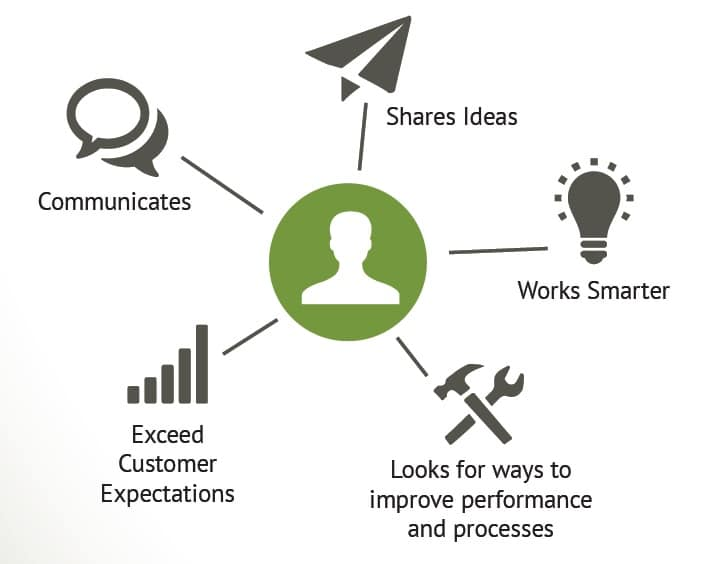Complete Guide: How to Develop and Conduct Company Surveys

Imagine if you could get feedback directly from your employers or customers regularly. Not just once, but as often as you wanted. You could find out what they liked and didn't like and how to make them happy. And all it would take is a quick survey.
That's the power of surveys. By gathering feedback from your employees, you can learn what works and doesn't work for them and make changes that will improve your organization.
This guide will teach you how to develop and conduct company or employee surveys to help you achieve your professional goals.
Employee Surveys and their Purpose

Employee surveys are a great way to measure employee engagement and satisfaction. They can also identify areas where employees may need more training or development.
Using an employee engagement platform, you can create and administer surveys quickly and easily. This will help you get feedback from your employees quickly and effectively.
Some of the reasons for using employee surveys include the following:
-
Gauging employee engagement and satisfaction
-
Identifying areas for improvement
-
Measuring employee motivation
-
Determining the effectiveness of training programs
-
Tracking changes in employee attitudes over time
To get the most out of your employee surveys, it is crucial to ensure they are well-designed and relevant to your employees. Through employee feedback, organizations can identify areas where they need to make changes. This allows you to gather valuable insights and make informed decisions quickly.
The Importance of Employee Engagement Surveys

Employee engagement surveys are crucial for organizations to measure employee engagement and identify actionable insights. By understanding employee engagement levels, organizations can take steps to improve the employee experience and boost productivity. An employee engagement survey provides critical feedback that helps organizations understand what is working well and where improvements can be made.
Developing Survey Questions

Market research is essential for understanding customer needs and preferences. When developing survey questions, it's critical to be creative and think outside the box. to get the most accurate results.
You'll want to tailor your questions to match your target population. Also, keep the employee lifecycle - from recruitment and onboarding to development and retention. By asking the right questions, you can gain valuable insights that can help you improve your organization.
Before drafting employee survey questions, you must decide on the survey's objectives. Once you have a clear idea of what you want to know, you can start drafting questions to help you achieve those objectives.
Some things to keep in mind when developing employee survey questions:
-
Keep the survey question concise and ensure the questions are relevant to the survey's objectives.
-
Make sure the questions are straightforward to understand.
-
Avoid leading or suggestive questions.
-
Don't ask for personal information such as name or address.
When creating survey questions, it's essential to be creative and engaging. You want respondents to feel interested in answering the questions and not see it as a chore. Use strong verbs and exciting adjectives to make the questions more appealing.
Conducting Employee Surveys with Respondents

But running an employee engagement survey can be a daunting task. How do you get respondents to participate? And once they do, how do you ensure that their feedback is meaningful and actionable?
One of the best ways to ensure the success of your employee survey is to use an engagement platform that provides an easy-to-use interface and customizable surveys.
With this platform, you'll be able to gather feedback from employees quickly and easily - without having to worry about the complexity of the process.
Here are a few tips for getting the most out of your employee engagement survey:
1. Make Participation Mandatory
If you want employees to take your survey seriously, make participation mandatory. This may seem like an authoritarian move, but it can be pretty effective in getting employees to respond.
2. Use an Incentive System
In addition to making participation mandatory, offer employees an incentive for completing the survey. This could be anything from a cash bonus to a free lunch. Whatever you choose, make sure that it's something that employees will find appealing.
3. Keep the Survey Short and Simple
Employees are more likely to respond if the survey is short and straightforward. Keep the questions concise and easy to understand. And avoid asking too many questions - you want employees to complete the survey, not get overwhelmed by it.
4. Follow Up with Employees' Real-Time Insights
Once the survey is complete, follow up with employees to see what actions have been taken based on their feedback. This shows that you're taking their suggestions seriously and that you're committed to making changes in the workplace for the better.
Analysis and Interpretation of Employee Survey Results

An employee survey can be a great way to get feedback from your team to identify areas where you may need to make changes. The result of the employee survey can be very telling and help you understand how your team feels about their work, their boss, and their job satisfaction.
If you're looking for ways to improve your organization, taking a close look at your employee engagement survey data is a good start. You may find that there are some areas of your company that are doing well but that there are also some areas that need improvement.
Looking at the employee survey data results can help you understand what makes your team happy and what makes them unhappy. This data can be helpful when you're trying to create a plan to improve your organization.
Too often, employee surveys are used to predict employee turnover. While this can be an essential use of performance reviews, it is vital to remember that many other key features contribute to employee turnover. Therefore, care should be taken to interpret the results of surveys to avoid drawing inaccurate conclusions.
If unsure where to start, look at employees' most common complaints through continuous feedback. This information can give you a good idea of the areas of your organization that need the most attention.
Overall, employee surveys can be a great way to get feedback from your team and identify areas where you may need to make changes. If you're looking for ways to improve your organization, taking a close look at the result of your employee survey is an excellent place to start.
Drawing Conclusions from Employee Survey Results
When it comes to employee surveys, there are a lot of conclusions that can be drawn. But one of the most important is figuring out what actions need to be taken to improve the employee experience.
For example, if a company finds that a large percentage of its staff is not engaged, it might decide to focus on employee recognition and appreciation programs. Or if a company finds that many employees are unhappy with their job duties, it might reorganize its departments or revise its company's performance management or leadership assessment.
There are countless ways to improve employee engagement, but the key is determining what specific actions need to be taken based on the survey's reliable data. And that's where the actual employee engagement survey data lies- pinpointing the areas that need improvement and then taking action for better understanding.
Improving Survey Response Rates

There are many ways to improve survey response rates, but one of the most important is the satisfaction of employees in the organization. Satisfied employees are more likely to respond to surveys, and they are also more likely to be engaged in their work.
Give Value to the Employees
One way to improve this is to ensure that employees feel heard and valued. This can be done through regular communication, employee recognition programs, and opportunities for real-time feedback.
Create a Positive Work Environment
Another way to improve satisfaction is to create a positive work environment. This includes providing employees with the resources they need to do their job, offering training and development opportunities, and creating a culture of respect.
If you want to improve your survey responses, focus on employees' satisfaction with the organization. By creating a positive work environment and listening to employees, you can encourage them to participate in your employee pulse surveys and give you valuable employee feedback as one of the employee engagement tools.
When creating a questionnaire, it's essential to make sure you get as many responses as possible. After all, the more answers you have, your results will be more accurate. So how can you improve your response rate? Here are a few tips through own questionnaires:
-
Make sure your questions are straightforward to understand.
-
Keep the survey short and sweet - no one wants to spend hours filling out questionnaires.
-
Incentivize respondents by offering rewards or discounts for completing the survey.
-
Send out reminder emails to those who haven't yet responded.
-
Use social media to spread the word about your survey.
-
Personalize the survey invitation with the respondent's name.
-
Be patient - don't give up if you don't receive responses immediately. Persistence is key!
Employees want to feel appreciated for their work; one way is through exit surveys. By completing an exit survey, employees can provide feedback on their time at the company and what could be improved. However, sometimes employees need to exit a survey before they're finished.
Measuring Employee Satisfaction through Survey Software
Employee satisfaction is vital for any company. A happy employee is productive, and organizations want to keep their employee as comfortable as possible. One way to measure happiness is through an employee engagement survey.
There are many different types of surveys, but one of the most popular is the employee Net Promoter Score (eNPS) survey. The eNPS survey asks employees how likely they are to recommend the company to a friend or family member. This is a simple question, but it can be one of the most effective survey tools for the organization.
If most employees say they are not likely to recommend the company, that's a sign that there may be some problems with satisfaction. On the other hand, if a majority of employees say they are likely to recommend the company, that's a sign that the company is doing something right.
The eNPS survey is just one way to measure employee satisfaction, but it's also one of the vital survey tools. Companies that want to keep their employees happy should consider using this employee engagement survey to understand how their employees feel.
Building a Culture of Employee Engagement Via Feedback System

Employee engagement is a critical part of large organizations, yet it cannot be easy to maintain a high level of engagement among employees.
One way to keep employee engagement high is through a feedback system that allows employees to provide feedback on their work and their experience at the company.
The gathered feedback can then improve employee engagement by addressing the issues that employees are most unhappy with as human resources.
A feedback system can also help to create an engaged company culture. When employees know that their feedback will be taken seriously and used to impact positively, they are more likely to be engaged in their work.
A feedback system also allows employees to feel like they are part of the company and that their opinions play a vital role in the organization's development.
Combining top-down and bottom-up approaches is the best way to build an engaged company culture. The top-down approach is when management sets the tone for employee engagement and establishes expectations for employee behavior.
The bottom-up approach is when employees are given a voice and are allowed to contribute to the workplace culture. A feedback system is a perfect way to implement the bottom-up approach.
For taking regular feedback from your employees, you can use google forms as one of the survey software solutions. Plus, google forms help you to collect real-time feedback through already engaged employees. In this regard, you must create surveys and share them with your staff.
Surveys are a valuable tool for HR professionals. Survey software is a great way to keep your employees engaged. They provide insights into employee engagement, satisfaction, and new onboarding processes. By developing recent hire surveys, you can gain important insights that can help improve your organization.
The Best Employee Engagement Survey Software - Jobini
Are you looking for the best employee engagement survey tool? Look no further than Jobini.
Our platform is designed to make it easy to create and administer surveys, analyze the results, and take action to improve employee engagement.
With Jobini, you'll get a clear picture of how your employees feel about their work and identify areas where your organization can improve.
Frequently Asked Questions
What are company surveys for?
The company survey measures employee engagement, motivation, and a sense of purpose in working or an organization.
Are company surveys really anonymous?
Disclosing employee data can be used to gain employee information. Some employees' identifications are attached to the response, therefore, are not anonymous. While some groups see the identifications, only some people within an organization can access them.
Do companies do surveys?
Many companies use survey methods to measure employees' motivation and performance. However, many of the time, this tool misses valuable information. A survey is a helpful tool for companies.
What are the three types of surveys?
There are three types of surveys: exploratory, descriptive, and causal.
Exploratory surveys are used to gather preliminary data about a topic. This type of survey is typically used to generate hypotheses or identify further study areas.
Descriptive surveys are used to describe the characteristics of a population. This type of survey is typically used to collect data that can be used to generate statistics.
Causal surveys are used to examine the relationship between two or more variables. This type of survey is typically used to test hypotheses about how changes in one variable affect another variable.
How much does an employee survey cost?
Employee satisfaction surveys range from $3k to $15k. Almost all employee surveys will meet your budget and can offer recommendations for minimizing or boosting costs.
Which company has the best employee engagement?
Microsoft Corporation. It is tough to find a company that is highly engaged with its workforce with a tech giant at the forefront. Through many channels, Microsoft employees have engaged the public with the company.
What is employee engagement software?
Employee Engagement software is a group of programs for boosting employees' productivity. It focuses mainly on helping employees understand the mission of their organization's culture.
What is the purpose of a company survey?
Surveys enable businesses to effectively gather accurate and objective feedback from customers and employees and to use this feedback to improve operations, reduce costs for customers, and develop new products.
Are company surveys compulsory?
Most employees' opinions survey surveys tend to be voluntary. Most respondents' answers have to include employee participation rates because this helps to strengthen the validity. The percentage of respondents in surveyed workplaces is rarely higher than the 100 % mark.

